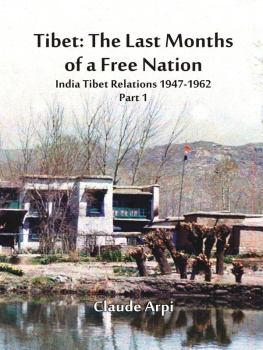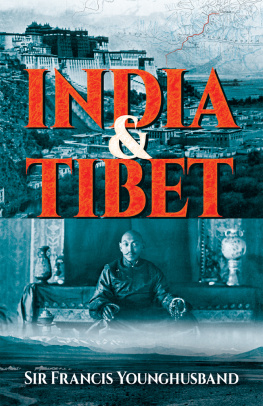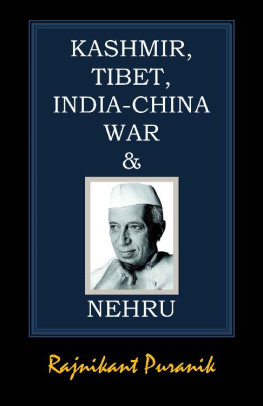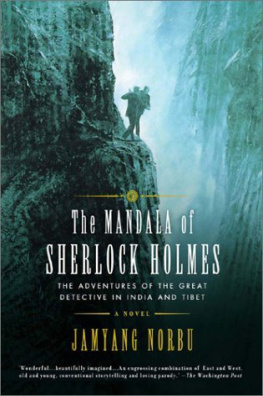The End of an Era: India Exits Tibet
India Tibet Relations (1947-1962)
Part 4
The End of an Era: India Exits Tibet
India Tibet Relations (1947-1962)
Part 4
Claude Arpi
United Service Institution of India
New Delhi
Vij Books India Pvt Ltd
New Delhi (India)
The End of an Era: India Exits Tibet
This book is Part 4 of the series on India Tibet Relations (1947-1962). Other books in the series are:
Part 1: Tibet: The Last Months of a Free Nation
Part 2: Will Tibet Ever Find Her Soul Again
Part 3: When The Gods Spoke
Published by
Vij Books India Pvt Ltd
(Publishers, Distributors & Importers)
2/19, Ansari Road
Delhi 110 002
Phones: 91-11-43596460, 91-11-47340674
Mobile: 98110 94883
e-mail:
Copyright 2020, United Service Institution of India, New Delhi
ISBN: 978-93-89620-71-9 (Hardback)
ISBN: 978-93-89620-72-6 (Paperback)
ISBN: 978-93-89620-73-3 (ebook)
All rights reserved.
No part of this book may be reproduced, stored in a retrieval system, transmitted or utilised in any form or by any means, electronic, mechanical, photocopying, recording or otherwise, without the prior permission of the copyright owner. Application for such permission should be addressed to the publisher.
I am indebted to the United Service Institution of India (USI) for offering me the Field Marshal KM Cariappa Chair of Excellence for this research on The relations between India and Tibet between 1947 and 1962 and grateful to the former Director, Lt Gen PK Singh, PVSM, AVSM (Retd), who initiated this project.
My sincere thanks to the new Director, Maj Gen BK Sharma, AVSM, SM** (Retd), who encouraged me to complete the study, Maj Gen Rajiv Narayanan, AVSM, VSM (Retd) Head (Research) & CS3, under which this research was conducted and Dr (Mrs) Roshan Khanijo, Assistant Director (Research), CS3, who helped me in many ways.
Maj Gen PK Goswami, VSM (Retd), Deputy Director (Adm) at the USI has always made it easy as far as the administrative aspects were concerned.
It has been a pleasure to be part of the USI family.
Very special heartfelt thanks to Maj Gen PJS Sandhu (Retd) who accepted to review the four volumes. Despite his numerous activities as a retired general, he has taken time to diligently go through the manuscript, making sharp comments, suggestions and corrections that I happily incorporated; it greatly enriched the manuscript. I found a close friend in the process.
My gratitude to my publishers, Brig PK Vij (Retd) and his son, Rohan.
My appreciation to the entire staff of the National Archives and the Nehru Memorial Museum & Library for their readiness to cope with my recurring demands.
I am indebted to Yuraj Singh, who allowed me to use one photo taken by his father Shri Jagdish Singh Chankla, in Yatung on the occasion of Prime Minister Nehrus visit in September 1958.
My daughter Smiti who is always supportive and helped in the design of the cover.
Thank you to Uma and Deepti for helping in the proofreading of this volume and to Lisa for the photos.
Finally, I have to express my great appreciation to Abha, my wife, for her unwavering support. She has been my daily counselor for these four volumes. I am sure she must be tired to hear about the Indian Consulate General in Lhasa or the Trade Agencies in Tibet, but she has patiently put up with me all these years, spending hours reading through the manuscripts and providing insightful comments.
The last volume of our study on the relations between India and Tibet (1947-62), undertaken under the Field Marshal KM Cariappa Chair of Excellence of the United Service Institution of India, is rather depressing, as it narrates the last years of the Indian presence in Tibet which ended under the most dramatic circumstances - a War. But first let us take a brief look at the first three volumes.
Volume 1
The first volume (1947-1951) recounted the tragedy that befell Tibet; not only did the Dalai Lama and his people lose their country, which had lived blissfully ignorant of the great revolutions reshaping the rest of the world, but it was a tragedy for India too as it lost a peaceful neighbour. Suddenly India had to share a border with Communist China whose ideology was the opposite of Buddhist values. At that time Delhi did not realize it, but a few years later, when India would understand that it had no more a secure northern border, it was too late.
Some wiser Indian officials and politicians immediately saw the implications of the change of neighbour, but their views were not honoured.
Letters, cables, telegrams and notes accessed by us, showed that two schools of thought emerged during the tumultuous months of November/December 1950: on one side were Prime Minister Jawaharlal Nehru and KM Panikkar, his ambassador in Beijing, both obsessed by an imaginary friendship with New China and fixated on the larger implications for World Peace; the other side feared the strategic implications for India.
In a way, the fate of Tibet and Indias borders with Tibet was sealed once Sardar Patel, who clearly foresaw and articulated the dangers of the Chinese annexation of Tibet for the Indian frontiers, passed away on December 15, 1950; it was hardly two months after the entry of the Peoples Liberation Army (PLA) in Eastern Tibet. Nehrus policy would have disastrous consequences which can still be felt today on the Indian borders, whether in Ladakh, Sikkim or Arunachal Pradesh.
Volume 2
The second volume (1951-1954) looked at the consequences of the signing of the 17-Point Agreement in May 1951; the Tibetan delegates had no alternative but to accept that the Tibetan people shall return to the family of the Motherland of the Peoples Republic of China and drive out imperialist aggressive forces from Tibet.
A two-phase operation was meticulously planned by Mao Zedong; the first part culminated in the Battle of Chamdo which saw the Tibetan forces being decimated; the Great Helmsmans second step was diplomatic, the weak Tibetan State was forced to put its thumb impression on an agreement allowing Communist China to take over the Land of Snows.
This period also saw the beginning of the Hindi-Chini-Bhai-Bhai honeymoon between Delhi and Beijing. Over the next months and years, the Indian officials posted on the Roof of the World would discover the true attitude and objectives of the Communists; but nobody in Delhi or the Indian Embassy in Beijing was ready to listen.
The slow break-down and deterioration of the age-old Indo-Tibet relations, gradually being replaced by a cruder relation with the new occupiers of Tibet, has been looked into in depth.
It ended with the signing of the 1954 Tibet Agreement to which the Tibetans were not even invited to participate. Indias long border with Tibet (now China) was wishfully deemed settled in the process, while the Chinese would wait to raise the issue at the appropriate time.
Volume 3
The third volume (1954-1957) studied the Chinese consolidation on the plateau after having secured the Indian withdrawal from Tibet through the 1954 Agreement.
Paradoxically or ironically, this period already witnessed the first Chinese intrusions in Barahoti, a small flat grazing ground located in todays Chamoli district of Uttarakhand. Though the first two of the Five Principles spoke of Mutual respect for each others territorial integrity and sovereignty and Mutual non-aggression, the Chinese troops walked into the Indian Territory, before the ink on the treaty had hardly dried.











